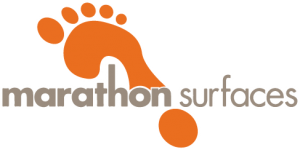For videos of answers to some of our frequently asked questions visit our VIDEOS page!
Is Marathon Surfaces a local company?
We are located in Surrey, BC. Marathon has been a supplier and installer of poured-in-place rubber surfaces and athletic surfaces throughout western Canada for over 20 years.
What is LANDSAFE®?
LANDSAFE® is Marathon’s proprietary poured-in-place rubber surfacing system.
What is poured-in-place rubber surfacing?
Poured-in-place refers to the installation process which involves mixing a binding agent and rubber granulate on site. The mixed material is then poured and troweled onto the sub-surface. The product then cures on site.
What other names do people use for poured-in-place rubber?
Although the most widely used and correct term in the industry is poured-in-place rubber surfacing (also known as PIP), it is also referred to as; poured rubber flooring, playground flooring, wet pour rubber surfacing, or rubberized playground surfacing.
What is the surfacing made from?
Poured-in-place rubber surfaces and running track systems are made from recycled rubber, natural rubber, and high-strength polyurethane binders. Synthetic turf materials are comprised of polyethylene fibers with surface infill such as recycled rubber, sand, or natural rubber.
How long does poured-in-place surfacing last?
Most well-maintained poured-in-place surfaces will last 8 years or more. After 8 years the surface should be inspected, and resurfacing should be considered. Often it is just the top wear course that shows wear and requires attention.
How do you clean the rubber surface?
The surface should be swept weekly to remove debris and organics. Stubborn marks or stains can be cleaned with commercial cleaners preferably citric based. We recommend a cleaning product such as ZEP EZ Product #0778 floor cleaner. The surface should be power washed once a year with a 45-degree fan spray tip. By keeping the surface clean and well maintained the life of the surface will be enhanced.
What about winter maintenance?
Snow shovels with plastic blades are recommended. Ice melt is the preferred product to use to prevent ice and slippery conditions. Pressure washing in the spring will remove any stains and residue. Sand is not recommended as it will clog and compromise the porosity of the surface.
Can the surface be easily repaired?
The surface can be repaired. We recommend that you contact Marathon Surfaces if any repairs are needed. Damage to the surface can be repaired however it does require experience and proper materials to repair properly.
How thick is the PIP rubber surface?
The thickness of the poured-in-place rubber surface depends on its application. The top wear coat of coloured rubber is 13mm (0.5”) thick in most applications. The recycled rubber base mat below the top wear coat ranges from 25mm (1”) to 150mm (6”) depending on the CSA fall height requirements.
What goes under the poured-in-place rubber or synthetic turf?
Minimum 100mm (4”) compacted aggregate base with borders. Poured-in-place rubber can also be installed directly on top of concrete, or asphalt.
Does water drain through the rubber?
Yes. The rubber is porous so water will drain through to the sub-base material or drain system. We can also install a non-porous system for certain water park applications.
Can poured-in-place rubber be installed on slopes?
Yes, it can be installed on slopes which makes it a great application for playgrounds that have mounds or sloped terrain.
Can we install the rubber ourselves?
Not recommended as installation requires experience and precise mixing ratios. The material cost (not labour) is by far the largest cost of the installation.
Are you certified?
Yes. We have certified playground inspectors on staff. Also, our running track systems are World Athletics Certified.
Does your product meet CSA standards?
Yes. LANDSAFE poured-in-place surfacing meets or exceeds current CSA Z614:20 fall height standards. Our products also meet ADA accessibility standards as well as LEED Canada criteria.
How much recycled rubber do you use a year?
Over 1,000,000 pounds each year.
Where does recycled rubber come from?
Recycled rubber comes from used tires. There are approximately 7 lbs. of recycled tire crumb (1/2 a car tire) per square foot of play surfacing. A 1000 square foot playground uses 7000 lbs. of recycled tire rubber which is approximately 500 car tires.
How much does it cost?
That really depends on the application, the area surface, the rubber thickness, and the colours and patterns. Please contact Marathon Surfaces for the best recommendations and pricing for your specific project.
